Arm Announces Mobile Armv9 CPU Microarchitectures: Cortex-X2, Cortex-A710 & Cortex-A510
by Andrei Frumusanu on May 25, 2021 9:00 AM EST- Posted in
- SoCs
- CPUs
- Arm
- Smartphones
- Mobile
- Cortex
- ARMv9
- Cortex-X2
- Cortex-A710
- Cortex-A510
A new CI-700 Coherent Interconnect & NI-700 NoC For SoCs
Finally, the last new announcement of the day is a new interconnect and network-on-chip generation. The last time Arm had announced a mobile/client interconnect was back in in 2015 with the CCI-550. The reason for the large gap between IPs, in Arm’s own words, is that ever since Arm’s introduction of the DSU in its CPU complexes, there really hasn’t been any need for a cache coherent interconnect in the market. While that’s eyebrow-raising from a GPU perspective, it makes perfect sense from a CPU perspective, as coherency between CPU cores was the primary driver for such interconnects until then.
With the advent of new more complex computing platforms, such as NPUs, accelerators, and hopeful more use of GPUs in cache-coherent fashions, Arm saw a need gap in its portfolio and decided to update its client-side interconnect IP.
The new CI-700 is a mobile and client optimised variant of Arm’s infrastructure CMN mesh network, implementing important new interoperability with the new IP announced today, such as the new DSU or CPU cores.
The new mesh interconnect scales up from 1 to 8 DSU clusters, and supports up to 8 memory controllers, and also introduces innovations such as a system level cache.
The mesh network topology and building blocks is very similar to what we’ve seen in the CMN infrastructure IP, in that “points” in the mesh are comprised of “cross-points” or “XP”. One differentiation that’s unique to the client mesh implementation is that XPs can have more attached connectivity ports, trading in routing connection paths. The new IP can also be configured as just a sole XP with no real mesh so to speak of, or essentially a 1x1 mesh configuration. This can grow up to a 4x3 mesh in the largest possible configuration.
The mesh supports from 1 to 8 SLC slices, with up to 4MB per slice for a total of 32MB, and snoop filter SRAM with coverage of up to 8MB address space per slice. It’s noted that generally Arm recommends 1.5-2x of coverage of the underlying private cache hierarchies of the mesh clients.
The SLC can server as both a bandwidth amplifier as well as reducing external memory/DRAM transactions, reducing system power reduction.
We see a reiteration of the support for MTE, allowing for this generation of IPs to support the feature across the new CPU IP, the DSU, and the new cache coherent interconnect.
Alongside the new CI-700 coherent interconnect, we’re also seeing a new NI-700 network-on-chip for non-coherent data transfers between a SoC’s various IP blocks. The big new improvements here is the introduction of packetization for data transfers, which leads to a reduction of wires and thus improves area efficiency of the NoC on the SoC.
Overall, the new system IP announced today is very interesting, but the one question that’s one has to ask oneself is exactly who these net interconnects are meant for. Over the last few years, we’ve seen essentially every major mobile vendor roll out their own in-house cache-coherent interconnect IP, such as Samsung’s SCI or MediaTek’s MCSI, and other times we don’t see vendors talk about their in-house interconnects at all (Qualcomm). Due to almost everybody having their own IP, I’m not sure what the likelihood would be that any of the big players would jump back to Arm’s own solutions – if somebody were to adopt it, it would rather be amongst the smaller name vendors and newcomers to the market. From a business and IP portfolio perspective, the new designs make a lot of sense and allows to have the building blocks to create a mostly Arm-only SoC, which is an important item to have on the menu for Arm’s more diverse customer base.


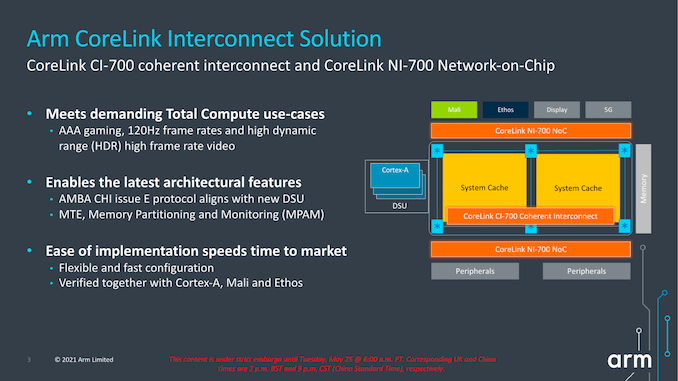

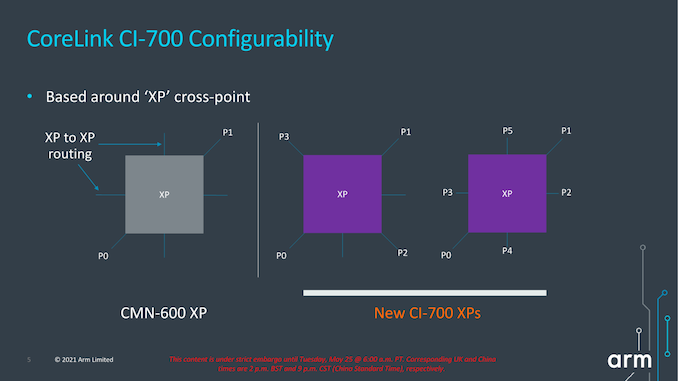
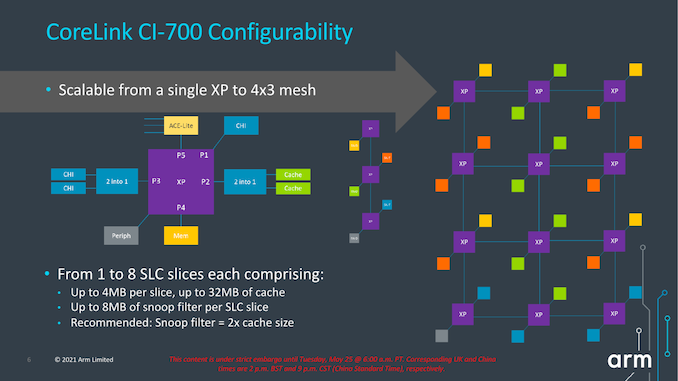
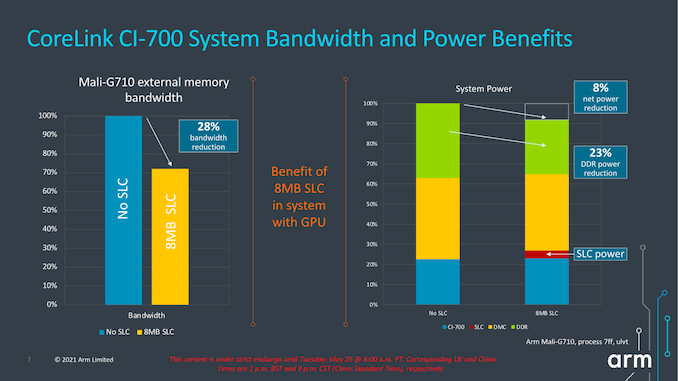
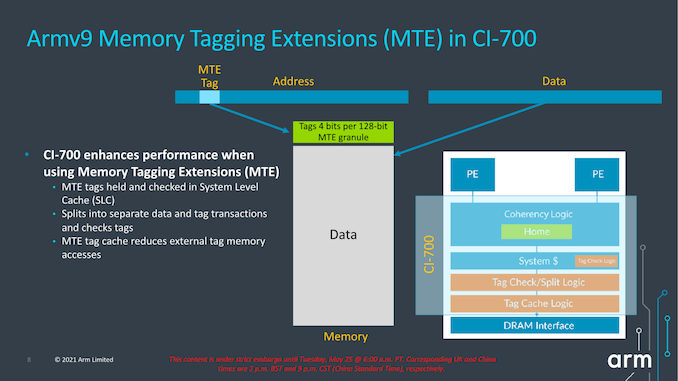









181 Comments
View All Comments
name99 - Tuesday, May 25, 2021 - link
Inrinsity was about circuit design.PA Semi was about microarchitecture.
There was a *lot* of good stuff in PA Semi! I have looked quickly at quite a few of the Intrinsity patents, but I don't know enough about that level of the stack to have any option as to how impressive they were. (This is not a criticism -- even if all that was picked up from Intrinsity was a number of competent engineers capable of implementing the micro-architecture ideas of the PA Semi folks, that's an essential part of shipping a chip!)
I'd honestly love someone who is familiar with the circuit level to look at the Intrinsity (low level and PA Semi patents, like for a new register file design) and let us know an informed opinion.
But as important as both of these has been Apple's willingness to keep pushing the envelope, to keep pouring money into design, to keep taking risks (every design change is a risk...) and not to accept "good enough". That might seem obvious except that, of course,
- Intel has been cruising on "good enough" for 10 years,
- QC (notoriously) made "good enough" its official response to the A7, and followed that up by cancelling Centriq, and
- ARM, for whatever reason, seems to alternate between designs that look like they're trying to at least approach Apple, and designs that feel like "good enough.
melgross - Tuesday, May 25, 2021 - link
Intrinsity was about efficiency. That was what they were known for.mode_13h - Wednesday, May 26, 2021 - link
> anyone in the non-iOS space is stuck with this attempt to inject some> Bulldozer design features into the tired in-order A55 lineage.
Well, they can have just one core per complex, instead of 2.
I'm not really sure why the hate, unless you think you're going to be running a lot of FP/vector threads.
melgross - Thursday, May 27, 2021 - link
That was the problem with Bulldozer. They made the same mistake.mode_13h - Saturday, May 29, 2021 - link
> That was the problem with Bulldozer. They made the same mistake.You mean the 2 cores per complex? But ARM is giving customers the option to order up an A510 with just 1 per complex, if you think you need enough FP/vector throughput to warrant it.
I think a lot of the hate being directed at the A510 is mere guilt by association. It's massively different than Bulldozer, but the sharing of that one feature really seems to have tainted it with all the negative feelings people have towards Bulldozer.
lemurbutton - Tuesday, May 25, 2021 - link
x86 is dead.AMD doing 5% to 15% improvements every year.
Intel doing -5% to 10% every year.
Meanwhile, Apple & ARM are doing 10 - 20%+ every year and including accelerators like machine learning.
M1 runs circles around anything AMD and Intel have. M1X and M2 will allow Apple to claim performance wins across all consumer computing devices. Can't wait for the 32/64 core Mac Pros too. It's going to be ugly for AMD/Intel.
SarahKerrigan - Tuesday, May 25, 2021 - link
I would be hesitant to lump in Apple and ARM, given how far apart the highest-performing shipping licensables and the highest-performing shipping Apple cores are.ARM is still a long way from matching peak AMD or Intel ST (not merely iso clock, where they do okay, but absolute) in any shipping product, and honestly, neither A710 nor X2 look especially groundbreaking. A510 looks really good, but mixed with a certain amount of "well, about frigging time."
ikjadoon - Tuesday, May 25, 2021 - link
I agree on point 1, sadly. The X1 earns 40 points on SPEC2006 1T Geomean, while the A14 broke 70 points and A13 is 59 points.The X2 vs A15 battle will be interesting in terms of power, but the X2 will likely be slower than the A13.
On the second, isn’t the A510 four years late and it has an almost identical power vs performance curve to the A55? Personally, I thought it was the smallest and saddest announcement today.
The only genuine A510 improvement is at the A55’s worst position / peak power: 10% faster for 20% less power. That’s four years later.
The rest of A510 power vs performance is by ramping up the power budget. That +10% perf for -20% power = 37.5% increase in perf-power over four years = 8% perf-power improvements per year. ;(
If they are sticking with in-order, I hoped the A510 could’ve done something more over four years.
Raqia - Tuesday, May 25, 2021 - link
Apple will rule the roost for the next year, at least until Nuvia's Phoenix cores make their debut some time in the second half of 2022 (that announced timeline likely means the design has taped out...) The cache hierarchy of Apple CPU complexes is simpler and fewer in level than what ARM's is capable of, which reflects the scope of their respective ambitions. ARM's hierarchy hobbles performance at mobile device scales but has much more headroom for supercomputing or server scale compute.Wilco1 - Tuesday, May 25, 2021 - link
Your numbers are off. AnandTech's SPECINT2006 results are 63.34 for A14 and 41.3 for SD888: https://images.anandtech.com/doci/16463/SPEC-power...TSMC 5nm offers ~15% speedup over 7nm, so 3.3-3.5GHz may be feasible (compared to 3.1GHz for SD865+ on 7nm), and that should get Cortex-X2 scores in the high 50's, close to the A14.
As for efficiency, it's unrealistic to expect major gains when starting from an already very efficient design. It's the same with performance, you can't expect a doubling of ST performance every few years like in the past.